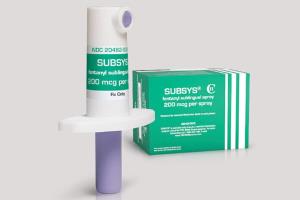
Insys (INSY) reported Q4 revenue of $31.5 million and eps of -$0.61. The company missed on revenue by $2.5 million and missed on eps by $0.47. However, the quarter was not all bad for Insys.
Revenue Appears To Be Stabilizing
Insys manufactures and markets two main drugs – subsys and syndros. Subsys delivers fentanyl, an opioid analgesic used for the treatment of breakthrough pain caused by cancer (“BTCP”) in opioid-tolerant patients. Syndros oral solution is approved for the second-line treatment of chemotherapy-induced nausea and vomiting (“CINV”) and anorexia associated with weight loss in patients with AIDS.
Subsys makes up over 95% of total revenue and it has been in free fall. The opioid crisis has prompted lawmakers to attempt to tamp down on prescriptions of opioids like subsys. The company’s total Q4 revenue of $34.1 million was off 46% Y/Y, but it grew 3% sequentially. The rate of decline in prescriptions for subsys improved slightly for the third consecutive quarter. The company believes subsys is the leading branded transmucosal immediate release fentanyl (“TIRF”) product. Management believes subsys can still address breakthrough pain suffered by cancer patients.
However, past subsys sales may have been driven by prescriptions for indications other than for critical care cancer patients. The reduction of prescriptions for non-cancer patients could cause subsys sales to remain flat to declining for some time. That said, syndros sales increased to $800 thousand in Q4 versus $684 thousand in Q3. The product was launched in August with Insys’s existing sales force. With additional investment, the product could potentially generate more top line growth.
Loss Of Scale Is Hurting Operating Results
Insys’s operating margins improved during the quarter, which indicates management is beginning to adjust to the decline in scale. Gross margin was 85%, up from 82% in the year-earlier period and 76% in Q3 2017. The company reduced the amount of stale inventory and continues to make improvements in its supply chain. Management cut total operating expenses to $46 million from $53 million in Q3 2016; however, its EBITDA was -$14 million versus $2 million in the year-earlier period due to a loss of scale. I expect more operating losses until the company can grow its top line.












Leave A Comment